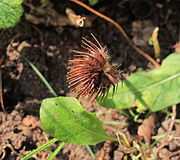Geum urbanum
| Geum urbanum | |
|---|---|
 | |
| Scientific classification | |
| Kingdom: | Plantae |
| (unranked): | Angiosperms |
| (unranked): | Eudicots |
| (unranked): | Rosids |
| Order: | Rosales |
| Family: | Rosaceae |
| Genus: | Geum |
| Species: | G. urbanum |
| Binomial name | |
| Geum urbanum L. | |
Geum urbanum, also known as wood avens, herb Bennet, colewort and St. Benedict's herb (Latin herba benedicta), is a perennial plant in the rose family (Rosaceae), which grows in shady places (such as woodland edges and near hedgerows) in Europe and the Middle East.
Usually reaching a height between 20 and 60 cm, wood avens blooms between May and August, and its flowers are 1 – 2 cm in diameter, having five bright yellow petals. The hermaphrodite flowers are scented and pollinated by bees. The fruits have burrs, which are used for dispersal by getting caught in the fur of rabbits and other animals. The root is used as a spice in soups and also for flavouring ale.

Geum urbanum hybridises fairly regularly with Geum rivale (water avens), as they are closely related and occur together.
In folklore
In folklore, wood avens is credited with the power to drive away evil spirits, and to protect against rabid dogs and venomous snakes. It was associated with Christianity because its leaves grew in threes and its petals in fives (reminiscent of, respectively, the Holy Trinity and the Five Wounds). Astrologically, it was said to be ruled by Jupiter.
In herbal medicine
Wood avens was stated to be a treatment for poison and dog bites. Paracelsus suggested its use against liver disease, catarrh and stomach upsets.
Geum urbanum herb and roots have been used in the traditional Austrian medicine internally as tea for treatment of rheumatism, gout, infections, and fever.[1]
Modern herbalists use it to treat diarrhoea, heart disease, halitosis and mouth ulcers, and to prevent colic. Not all of these uses are supported by scientific evidence.
References
- ↑ Vogl, S; Picker, P; Mihaly-Bison, J; Fakhrudin, N; Atanasov, A. G.; Heiss, E. H.; Wawrosch, C; Reznicek, G; Dirsch, V. M.; Saukel, J; Kopp, B (2013). "Ethnopharmacological in vitro studies on Austria's folk medicine--an unexplored lore in vitro anti-inflammatory activities of 71 Austrian traditional herbal drugs". Journal of Ethnopharmacology 149 (3): 750–71. doi:10.1016/j.jep.2013.06.007. PMC 3791396. PMID 23770053.
Sources
- Howard, Michael. Traditional Folk Remedies (Century, 1987), pp 99–100.